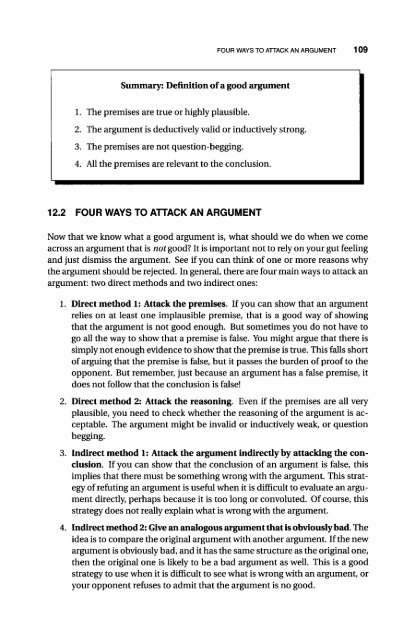An Introduction to Critical Thinking and Creativity - always yours
An Introduction to Critical Thinking and Creativity - always yours
An Introduction to Critical Thinking and Creativity - always yours
You also want an ePaper? Increase the reach of your titles
YUMPU automatically turns print PDFs into web optimized ePapers that Google loves.
FOUR WAYS TO ATTACK AN ARGUMENT 109<br />
Summary: Definition of a good argument<br />
1. The premises are true or highly plausible.<br />
2. The argument is deductively valid or inductively strong.<br />
3. The premises are not question-begging.<br />
4. All the premises are relevant <strong>to</strong> the conclusion.<br />
12.2 FOUR WAYS TO ATTACK AN ARGUMENT<br />
Now that we know what a good argument is, what should we do when we come<br />
across an argument that is nor good? It is important not <strong>to</strong> rely on your gut feeling<br />
<strong>and</strong> just dismiss the argument. See if you can think of one or more reasons why<br />
the argument should be rejected. In general, there are four main ways <strong>to</strong> attack an<br />
argument: two direct methods <strong>and</strong> two indirect ones:<br />
1. Direct method 1: Attack the premises. If you can show that an argument<br />
relies on at least one implausible premise, that is a good way of showing<br />
that the argument is not good enough. But sometimes you do not have <strong>to</strong><br />
go all the way <strong>to</strong> show that a premise is false. You might argue that there is<br />
simply not enough evidence <strong>to</strong> show that the premise is true. This falls short<br />
of arguing that the premise is false, but it passes the burden of proof <strong>to</strong> the<br />
opponent. But remember, just because an argument has a false premise, it<br />
does not follow that the conclusion is false!<br />
2. Direct method 2: Attack the reasoning. Even if the premises are all very<br />
plausible, you need <strong>to</strong> check whether the reasoning of the argument is acceptable.<br />
The argument might be invalid or inductively weak, or question<br />
begging.<br />
3. Indirect method 1: Attack the argument indirectly by attacking the conclusion.<br />
If you can show that the conclusion of an argument is false, this<br />
implies that there must be something wrong with the argument. This strategy<br />
of refuting an argument is useful when it is difficult <strong>to</strong> evaluate an argument<br />
directly, perhaps because it is <strong>to</strong>o long or convoluted. Of course, this<br />
strategy does not really explain what is wrong with the argument.<br />
4. Indirect method 2: Give an analogous argument that is obviously bad. The<br />
idea is <strong>to</strong> compare the original argument with another argument. If the new<br />
argument is obviously bad, <strong>and</strong> it has the same structure as the original one,<br />
then the original one is likely <strong>to</strong> be a bad argument as well. This is a good<br />
strategy <strong>to</strong> use when it is difficult <strong>to</strong> see what is wrong with an argument, or<br />
your opponent refuses <strong>to</strong> admit that the argument is no good.
















